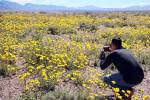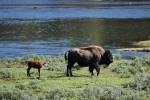Corn Creek Field Station to get massive makeover
The vast portion of desert and mountains north of Las Vegas known as the Desert National Wildlife Range annually lures thousands of visitors who like to hike, watch wildlife or follow the rugged back roads into seldom-visited remote areas. Created in 1936 as a refuge for the elusive desert bighorn sheep, the 1.5 million-acre wildlife area remains the largest in the lower 48 states. It protects not only the sheep, but other endangered or threatened species and millions of acres of back country largely untouched for five years. It is administered as part of a complex of Southern Nevada desert refuges by the U.S. Fish and Wildlife Service.
Corn Creek Field Station, the most accessible part of the huge refuge, lies just 23 miles north of Las Vegas on U.S. 95, then about four miles east on a gravel road. Site of a former ranch and early stage stop, Corn Creek Station is about a month into a period of demolition and reconstruction in advance of the first major improvement there in decades. Ground breaking slated for early June starts a 15-month project to construct an 11,000 square-foot visitor center with exhibit space, as well as administrative offices and a new maintenance building. When completed in late 2012, the project will include enlarged parking areas for visitors and employees, new signing for trails and rehabilitation of disturbed landscaping. Funding for the $7 million project comes from the Southern Nevada Public Lands Management Act.
Corn Creek Station at present provides limited visitor information in the form of a kiosk with sun-faded displays on plants, animals, history and purpose of the Desert Wildlife Range. A trailer that served as a visitor center since 2000 closed in October and was removed. Occasionally, volunteers are on hand to assist visitors.
Construction now under way impacts the site in a number of ways. A temporary pipe system carries water from Corn Creek through an area where heavy equipment enlarges and deepens the upper pool. Some trees and vegetation and part of the poolside trail are gone. Restrooms are closed and will be demolished. Orange mesh fencing delineates the construction area.
The project mainly affects the pools and creek closest to the existing parking area and the information kiosk. Foot trails on the east side of the creek and around the lower ponds are still accessible. The pupfish refugium is still in place. Visitors still enjoy walking the trails and spotting the large number of bird species that frequent the stands of trees, cattail-choked marshy areas, remaining orchard trees and open fields. Wildlife viewing is best early in the morning and in late afternoon, preferably when heavy equipment is not working. A new birding trail built by volunteers from the Red Rock Audubon Society last winter wanders through the sage and brush, easily followed, but unmarked. It and other paths at Corn Creek will be properly signed when the project is completed.
Enhanced storage in the upper pond will make the water accessible for use in the new building's air-conditioning and fire-suppression systems. The visitor center will meet "green" design standards. The building's colors and profile should blend nicely with the surrounding desert, echoing the stone "layers" evident in the nearby mountains. Native shrubs and trees will be used in landscaping of the area disturbed by construction.
Corn Creek may well become more of a destination than in recent decades. The old ranch is the closest point to the largest population in the state. The new facilities at Corn Creek will do a better job of introducing the Desert National Wildlife Range to its visitors. New exhibits should explain, educate and inform visitors about the objectives of the refuge and the desert wildlife it protects.
Not much else will change within the refuge. There will be no gasoline available. Water will be scarce. The roads will remain rough and dusty. Cell phone service will likely be spotty at best. Developed facilities outside of Corn Creek will still be almost nonexistent. The remote points of interest will still be many long miles away. Those who prefer to hike, ride horseback, follow unpaved roads, picnic and camp in solitude will continue to have 1.5 million acres in which to do so.
Margo Bartlett Pesek's column appears on Sundays.




























